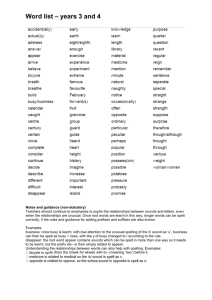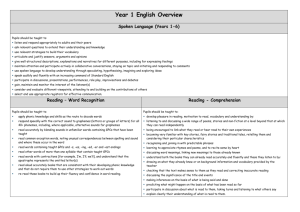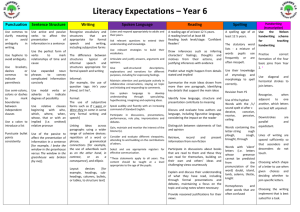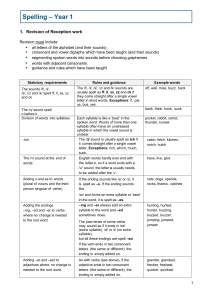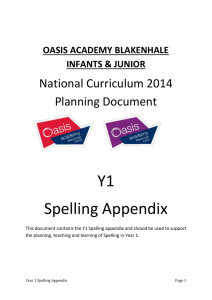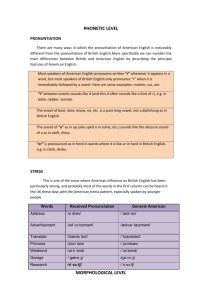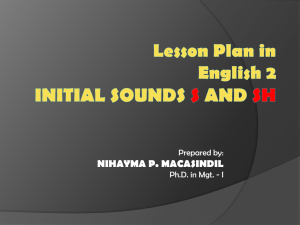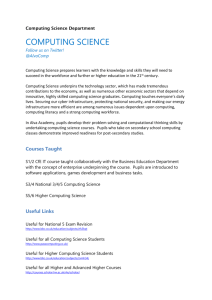English National Curriculum: Year 1 Overview
advertisement
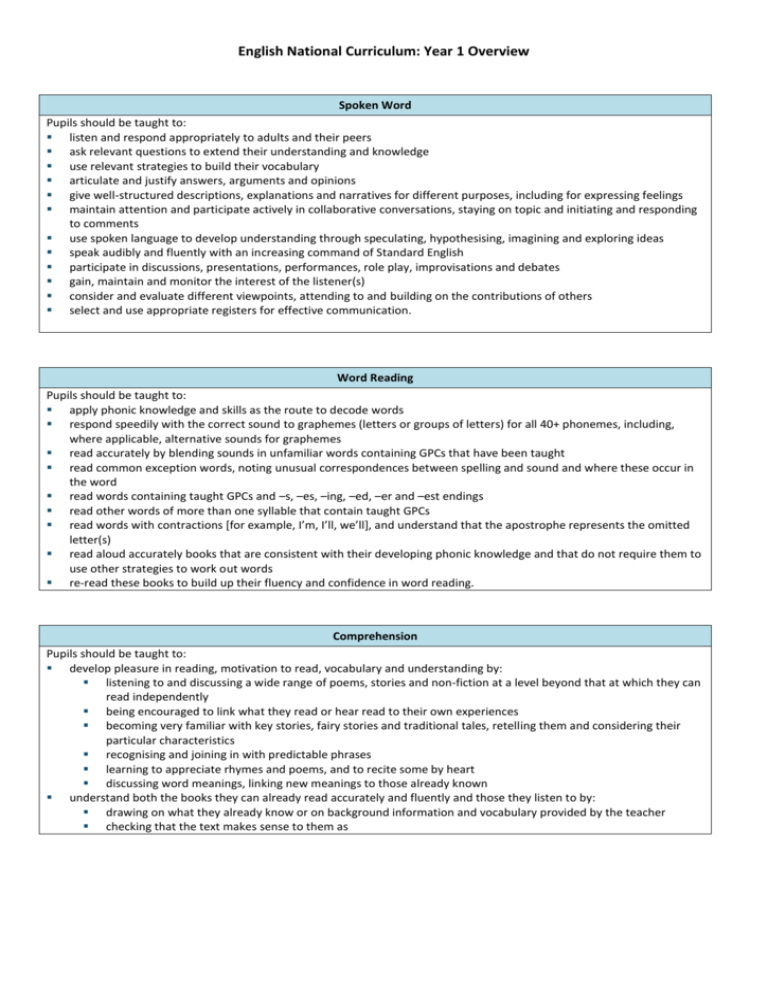
English National Curriculum: Year 1 Overview Spoken Word Pupils should be taught to: listen and respond appropriately to adults and their peers ask relevant questions to extend their understanding and knowledge use relevant strategies to build their vocabulary articulate and justify answers, arguments and opinions give well-structured descriptions, explanations and narratives for different purposes, including for expressing feelings maintain attention and participate actively in collaborative conversations, staying on topic and initiating and responding to comments use spoken language to develop understanding through speculating, hypothesising, imagining and exploring ideas speak audibly and fluently with an increasing command of Standard English participate in discussions, presentations, performances, role play, improvisations and debates gain, maintain and monitor the interest of the listener(s) consider and evaluate different viewpoints, attending to and building on the contributions of others select and use appropriate registers for effective communication. Word Reading Pupils should be taught to: apply phonic knowledge and skills as the route to decode words respond speedily with the correct sound to graphemes (letters or groups of letters) for all 40+ phonemes, including, where applicable, alternative sounds for graphemes read accurately by blending sounds in unfamiliar words containing GPCs that have been taught read common exception words, noting unusual correspondences between spelling and sound and where these occur in the word read words containing taught GPCs and –s, –es, –ing, –ed, –er and –est endings read other words of more than one syllable that contain taught GPCs read words with contractions [for example, I’m, I’ll, we’ll], and understand that the apostrophe represents the omitted letter(s) read aloud accurately books that are consistent with their developing phonic knowledge and that do not require them to use other strategies to work out words re-read these books to build up their fluency and confidence in word reading. Comprehension Pupils should be taught to: develop pleasure in reading, motivation to read, vocabulary and understanding by: listening to and discussing a wide range of poems, stories and non-fiction at a level beyond that at which they can read independently being encouraged to link what they read or hear read to their own experiences becoming very familiar with key stories, fairy stories and traditional tales, retelling them and considering their particular characteristics recognising and joining in with predictable phrases learning to appreciate rhymes and poems, and to recite some by heart discussing word meanings, linking new meanings to those already known understand both the books they can already read accurately and fluently and those they listen to by: drawing on what they already know or on background information and vocabulary provided by the teacher checking that the text makes sense to them as Writing – transcription Spelling (see below) Pupils should be taught to: spell: words containing each of the 40+ phonemes already taught common exception words the days of the week name the letters of the alphabet: naming the letters of the alphabet in order using letter names to distinguish between alternative spellings of the same sound add prefixes and suffixes: using the spelling rule for adding –s or –es as the plural marker for nouns and the third person singular marker for verbs using the prefix un– using –ing, –ed, –er and –est where no change is needed in the spelling of root words [for example, helping, helped, helper, eating, quicker, quickest] apply simple spelling rules and guidance, as listed in English Appendix 1 write from memory simple sentences dictated by the teacher that include words using the GPCs and common exception words taught so far. Writing – Handwriting Pupils should be taught to: sit correctly at a table, holding a pencil comfortably and correctly begin to form lower-case letters in the correct direction, starting and finishing in the right place form capital letters form digits 0-9 understand which letters belong to which handwriting ‘families’ (i.e. letters that are formed in similar ways) and to practise these. Writing – Composition Pupils should be taught to: write sentences by: saying out loud what they are going to write about composing a sentence orally before writing it sequencing sentences to form short narratives re-reading what they have written to check that it makes sense discuss what they have written with the teacher or other pupils read aloud their writing clearly enough to be heard by their peers and the teacher. Writing – Grammar, Vocabulary and Punctuation Pupils should be taught to: develop their understanding of the concepts set out in English Appendix 2 by: leaving spaces between words joining words and joining clauses using and beginning to punctuate sentences using a capital letter and a full stop, question mark or exclamation mark using a capital letter for names of people, places, the days of the week, and the personal pronoun ‘I’ learning the grammar for year 1 in English Appendix 2 use the grammatical terminology in English Appendix 2 in discussing their writing. Year 1: Grammar and Punctuation Objectives Term 1: Term 2 (reinforce and apply Term 1 objectives throughout): Separation of words with Question marks and spaces. exclamation marks to demarcate sentences. Introduction to capital letters and full stops. Joining words and joining clauses using and. Capital letters for names and for the personal pronoun I. Sequencing sentences to form short narratives. How words can combine to make sentences. Terminology: letter, capital letter, word, sentence, punctuation, full stop. Terminology: question mark, exclamation mark. Term 3 (reinforce and apply Term 1 and 2 objective throughout): Regular plural noun suffixes –s or –es (for example, dog, dogs; wish, wishes), including the effects of these suffixes on the meaning of the noun. Suffixes that can be added to verbs where no change is needed in the spelling of the root words (e.g. helping, helped, helper). How the prefix un- changes the meaning of verbs and adjectives (negation, e.g. unkind, undoing, untie the boat) Terminology: singular, plural. Spelling – work for year 1 Revision of reception work Statutory requirements The boundary between revision of work covered in Reception and the introduction of new work may vary according to the programme used, but basic revision should include: all letters of the alphabet and the sounds which they most commonly represent consonant digraphs which have been taught and the sounds which they represent vowel digraphs which have been taught and the sounds which they represent the process of segmenting spoken words into sounds before choosing graphemes to represent the sounds words with adjacent consonants guidance and rules which have been taught Statutory requirements Rules and guidance (non-statutory) The sounds /f/, /l/, /s/, /z/ and /k/ spelt ff, ll, ss, zz and ck The /f/, /l/, /s/, /z/ and /k/ sounds are usually spelt as ff, ll, ss, zz and ck if they come straight after a single vowel letter in short words. Exceptions: if, pal, us, bus, yes. The /ŋ/ sound spelt n before k Division of words into syllables Example words (non-statutory) off, well, miss, buzz, back bank, think, honk, sunk Each syllable is like a ‘beat’ in the spoken word. Words of more than one syllable often have an unstressed syllable in which the vowel sound is unclear. pocket, rabbit, carrot, thunder, sunset Statutory requirements Rules and guidance (non-statutory) -tch The /tʃ/ sound is usually spelt as tch if it comes straight after a single vowel letter. Exceptions: rich, which, much, such. English words hardly ever end with the letter v, so if a word ends with a /v/ sound, the letter e usually needs to be added after the ‘v’. If the ending sounds like /s/ or /z/, it is spelt as –s. If the ending sounds like /ɪz/ and forms an extra syllable or ‘beat’ in the word, it is spelt as –es. Example words (non-statutory) catch, fetch, kitchen, notch, hutch The /v/ sound at the end of words Adding s and es to words (plural of nouns and the third person singular of verbs) Adding the endings –ing, – ed and –er to verbs where no change is needed to the root word Adding –er and –est to adjectives where no change is needed to the root word –ing and –er always add an extra syllable to the word and –ed sometimes does. The past tense of some verbs may sound as if it ends in /ɪd/ (extra syllable), /d/ or /t/ (no extra syllable), but all these endings are spelt –ed. If the verb ends in two consonant letters (the same or different), the ending is simply added on. As with verbs (see above), if the adjective ends in two consonant letters (the same or different), the ending is simply added on. have, live, give cats, dogs, spends, rocks, thanks, catches hunting, hunted, hunter, buzzing, buzzed, buzzer, jumping, jumped, jumper grander, grandest, fresher, freshest, quicker, quickest Vowel digraphs and trigraphs Some may already be known, depending on the programmes used in Reception, but some will be new. Vowel digraphs Rules and guidance (non-statutory) Example words (non-statutory) and trigraphs ai, oi The digraphs ai and oi are virtually never rain, wait, train, paid, afraid used at the end of English words. oil, join, coin, point, soil ay, oy ay and oy are used for those sounds at the day, play, say, way, stay end of words and at the end of syllables. boy, toy, enjoy, annoy a–e made, came, same, take, safe e–e these, theme, complete i–e five, ride, like, time, side o–e home, those, woke, hope, hole u–e Both the /u:/ and /ju:/ (‘oo’ and ‘yoo’) June, rule, rude, use, tube, tune sounds can be spelt as u–e. ar car, start, park, arm, garden ee see, tree, green, meet, week ea (/i:/) sea, dream, meat, each, read (present tense) ea (/ɛ/) head, bread, meant, instead, read (past tense) er (/ɜ:/) (stressed sound): her, term, verb, person er (/ə/) (unstressed schwa sound): better, under, summer, winter, sister ir girl, bird, shirt, first, third ur turn, hurt, church, burst, Thursday Vowel digraphs and trigraphs oo (/u:/) oo (/ʊ/) oa oe ou ow (/aʊ/) ow (/əʊ/) ue ew ie (/aɪ/) ie (/i:/) igh or ore aw au air ear ear (/ɛə/) are (/ɛə/) Rules and guidance (non-statutory) Example words (non-statutory) Very few words end with the letters oo, although the few that do are often words that primary children in year 1 will encounter, for example, zoo food, pool, moon, zoo, soon The digraph oa is very rare at the end of an English word. The only common English word ending in ou is you. Both the /u:/ and /ju:/ (‘oo’ and ‘yoo’) sounds can be spelt as u–e, ue and ew. If words end in the /oo/ sound, ue and ew are more common spellings than oo. book, took, foot, wood, good boat, coat, road, coach, goal toe, goes out, about, mouth, around, sound now, how, brown, down, town own, blow, snow, grow, show blue, clue, true, rescue, Tuesday new, few, grew, flew, drew, threw lie, tie, pie, cried, tried, dried chief, field, thief high, night, light, bright, right for, short, born, horse, morning more, score, before, wore, shore saw, draw, yawn, crawl author, August, dinosaur, astronaut air, fair, pair, hair, chair dear, hear, beard, near, year bear, pear, wear bare, dare, care, share, scared Statutory requirements Words ending –y (/i:/ or /ɪ/) New consonant spellings ph and wh Using k for the /k/ sound Adding the prefix –un Compound words Common exception words Rules and guidance (non-statutory) Example words (non-statutory) very, happy, funny, party, family The /f/ sound is not usually spelt as ph in short everyday words (e.g. fat, fill, fun). The /k/ sound is spelt as k rather than as c before e, i and y. The prefix un– is added to the beginning of a word without any change to the spelling of the root word. Compound words are two words joined together. Each part of the longer word is spelt as it would be if it were on its own. Pupils’ attention should be drawn to the grapheme-phoneme correspondences that do and do not fit in with what has been taught so far. dolphin, alphabet, phonics, elephant when, where, which, wheel, while Kent, sketch, kit, skin, frisky unhappy, undo, unload, unfair, unlock football, playground, farmyard, bedroom, blackberry the, a, do, to, today, of, said, says, are, were, was, is, his, has, I, you, your, they, be, he, me, she, we, no, go, so, by, my, here, there, where, love, come, some, one, once, ask, friend, school, put, push, pull, full, house, our – and/or others, according to the programme used Appendix 2: Vocabulary, grammar and punctuation Year 1: Detail of content to be introduced (statutory requirement) Word Regular plural noun suffixes –s or –es [for example, dog, dogs; wish, wishes], including the effects of these suffixes on the meaning of the noun Suffixes that can be added to verbs where no change is needed in the spelling of root words (e.g. helping, helped, helper) How the prefix un– changes the meaning of verbs and adjectives [negation, for example, unkind, or undoing: untie the boat] Sentence How words can combine to make sentences Joining words and joining clauses using and Text Sequencing sentences to form short narratives Punctuation Separation of words with spaces Introduction to capital letters, full stops, question marks and exclamation marks to demarcate sentences Capital letters for names and for the personal pronoun I Terminology for letter, capital letter pupils word, singular, plural sentence punctuation, full stop, question mark, exclamation mark
